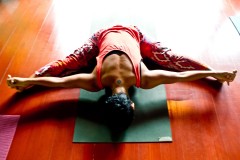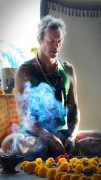Menu: About | Staying | Learning | Connecting | Giving
Get in touch! [email protected] | Getting Here
Jungleyoga Philosophy
by Randall O’Leary, founder of Jungleyoga Ashram
 The Basics of the Teacher Training Course
The Basics of the Teacher Training Course
The Jungleyoga 200-hour Teacher Training course is designed to be a comprehensive look at what the basic and essential elements of yoga practice are. This is good for people who want to understand yoga better and/or those who want to be teachers. If we have a good grasp of the essential elements of yoga, then we can build upon a solid foundation. When one understands the fundamentals of practice, then each person can choose their own direction and areas of interest and study, and thus go deeper.
To me, personal growth is the most important part of the course. A person cannot learn to share yoga knowledge with others if they have not gone on their own personal journey. I leave the course very open so that students can explore their own interests and needs. This includes creative work with the postures (students change them according to their own needs) and many other possible directions a person can take. The course is designed to be very open and spacious so people can learn about what they are interested in and grow in the direction that their hearts lead them.
There are certain basics that are essential to grasp so that practice can be both transformative and sustainable (i.e. safe). Of course, the physical body is the root of most Hatha yoga practice so we will look in depth at postures and alignments. The breath is the source of life, and we will look very deeply at the nature of the breath and how it works. Mind is also a critical piece of the puzzle, so we will study the mind so we can be masters of it and not slaves!
Behind the physical practice lies the philosophy and methodology of yoga. To know yoga better, we will look into the writings and literature of yoga, mainly through the Yoga Sutras of Patanjali and the Hatha Yoga Pradipika, as well as other texts. Our most important focus is on the philosophy of Tantra and how that guides both practice and life.
To me, the most important element is experience of the yoga, not just talking about it! So we spend plenty of time trying out the ideas and methods for ourselves. Only in this way will we really understand the yoga. Mornings we will practice the methods that we will explore the concepts of in the afternoon.
 Postures
Postures
The physical body is the primary tool in modern yoga, and it will be our primary tool as well. Since asana (posture) is our primary method of transformation, it is necessary to understand it thoroughly. There are many methods and approaches to the postures in yoga, and Jungleyoga is no exception. Every morning we will practice yoga postures and explore many different possibilities and combinations of practice. Although Jungleyoga is not a trademarked ‘style’ (such as Ashtanga, Iyengar, Kundalini, etc) we do have a guiding philosophy behind our practice and specific ways we approach the postures and practice using a 3-Part system.
The 3-Part system helps us understand how the Asana practice works. The course will begin with the ’shapes of the spine‘ (twists, forward bends, backbends, etc). We will investigate (and practice) those shapes and understand how and why they work and what they do. We will then look at the variations in arm and leg positions, so we can see how these affect the postures. Finally, we look at the roots of the postures and what their roles are. Then we put them together so that we can look at any posture and understand its essence: physically, energetically and mental/emotionally.
What is also critical in the practice is sequencing from posture to posture. Thus, we must learn what the energetics of the postures are so that we can put them in the correct places in the practice. Each posture has an energetic intensity and direction (or flavor) and we must grasp this energy if we are to use the postures for what they are: tools for our transformation. When we understand the energetic intensity, then we learn how to sequence the postures (put them in the correct order) so that we are working in the best and most effective way we can.
 Breath and Swara Cycles
Breath and Swara Cycles
To me, the breath is the most transformative and essential element in the yoga practice. The breath is the life force; it is the most influential force on body, energy, mind, emotions, health, attitude, perception, etc. Thus, we work very strongly to connect with the breath and use its natural power. Every day we practice, we spend the first hour on the development of breath.
Basically, we try to purify the breath and its movements so that it purifies in turn the rest of our being. Why not go directly to the source instead of messing about with edges? Jungleyoga has a very effective method to approach the breath development. These are called the Swara cycles.
Swara cycles are breath-focused movement cycles. We use the movement of the physical body to build the breath cycles and thus the internal energy (prana), which is so important to good yoga practice. The beginning Swara cycles are simple and anyone can perform them. They are a wonderful teaching tool for helping students make good contact with the breath, no matter what a person’s ability or experience is. Jungleyoga works with a number of basic cycles and then builds upon them to increase the intensity and power of the work. Even though they start simply, the cycles can be taken to nearly any level of difficulty that one desires. Once again, the emphasis is on understanding the tools that we have in front of us; then we can use these tools in whatever way we see fit.
We will also explore all of the basic Pranayama breaths including Ujjaii, Viloma, Kapalabatti, Kumbhakas and ratio breathing among others, largely in the context of the Swara cycles.
Bandhas and Chakras
As we get deeper into the course, we will look at the bandhas and the chakras. These are more advanced and esoteric yoga practices that we touch on but do not go deeply into. That is more the subject of the 500 Hour Training (Level 2). We do, however, spend a week on the chakras and explore their relationship to life and yoga practice.
The 200-hour Level 1 course is designed to create a stable foundation for us to build upon. We try not to go too deeply into difficult or complicated practices in Level 1 because I have found that so many people are lacking good fundamentals. Certainly every yogini can benefit from the development of the essentials. Personally, I feel that advanced practice does not have to be complicated. In fact, the simple is the more profound and the person who can practice the simple well will be deep and concentrated in every situation of yoga and life.
Anatomy
The western-style anatomy lessons are not a huge part of the course. We will learn what is necessary for understanding the postures and breaths, but the anatomy lessons will not be comprehensive. We will look at the various systems and processes of the physical body to help us understand how and why the yoga works, but the focus of the course will be more of a classical nature.
Any deeper study of anatomy can be done by the student on their own time. Trying to teach anatomy deeply takes too much time, and there are so many other, more important, things to do. The best way to learn about the yogic body is to practice and know the asanas. There was no western style anatomy in the ancient yogas and it is not so critical for our work.
 Mind and Meditation
Mind and Meditation
In yoga, the mind is both a powerful tool and the greatest obstacle to our growth. Thus we will explore the mind in various ways, both in concept and in practice. The first hour of the morning will be dedicated to meditation techniques, breath and mantras. It is crucial to develop some sort of meditation/mantra practice and we will take time to do so. There are many methods and we will explore some of them so that students can try them and understand for themselves.
We will develop internal mantra practice, external mantras, mind concentration, sound meditation, energetic meditation, breath meditation and many other forms of yogic concentration work. We also do some Tai Chi on occasion, to give some variations on meditation techniques.
Much of the philosophy of yoga is dedicated to the workings of the mind (Patanjali), so afternoon class will also explore this side of yoga. Knowing philosophy helps us to understand the workings of the mind and consciousness.
Mantra
In my personal experience, mantra has played a very powerful role. I have been taught many mantras by my teacher, Amargiri Nagababa of India. I love to pass on this knowledge to students of the training. We will learn various mantras over the course of the course and then apply them during simple rituals with fire (homa). This is a fun part of the course! Every few days we have an evening session of the training, and this is where we practice some rituals and mantras in a more classical style. Please keep in mind that the course uses mantras in Sanskrit, some of which are directed to energies that could be called ‘deities’. If this approach presents a big problem for you, you may look around for a different training!
 Philosophy and Tantra
Philosophy and Tantra
The most important concept in the training is that of integration. Too often I have found that philosophy seems to be disconnected from the actual practice of yoga. The philosophy is not just ideas, but practical knowledge that we can apply to our journey of growth; this can be called ‘practical philosophy.’ We will look at how the ideas of yoga work inside and behind what we do on the mat. Yoga is an experimental and experiential science! In this course, the philosophy will support what we are learning about the body, the energy, the mind and all the yoga techniques. In this way, we can have the intelligence guiding our work because we understand why we are doing a practice, what we are trying to accomplish and how to accomplish it.
The course is structured so that all of the practices that we do are integrated and support each other. Every day we learn something new, which is a continuation of what we have learned previously and which will support what will be done later. Yoga is a practice that develops only when one builds upon the foundations. This approach creates a very dynamic understanding and experience of yoga, due to the fact that yoga cannot be learned quickly. The only way yoga can be truly understood is by experiencing each step in its rightful place. The philosophy is the light that guides us along the path.
These philosophy lessons will include The Yoga Sutras of Patanjali and aspects of Tantra, both of which are critical for understanding not only how yoga works and what we can do with it, but for understanding ourselves and our inner nature.
The Yoga Sutras of Patanjali is the oldest book of yoga philosophy, upon which nearly every yoga system is based. Tantra is the practical philosophy that is applied to both life and yoga. It gives a depth and clarity to all aspects of life and it provides a framework for us to view the yoga and its methods and aims. Common views of Tantra give it a largely sexual nature. We will discuss why this is, and how it fits into the larger practice of Tantra, but sexual techniques will not be taught. Sorry. We will, however, learn about the Tantric world-view and why it is so important to yogic exploration.
 Teaching Methods and Practice
Teaching Methods and Practice
Some people are interested in becoming yoga teachers and some are not. The course is not centered around creating yoga teachers, but in creating yogis. By becoming a dedicated yogi (or yogini) it is possible to then teach, because one actually knows the practice deeply. Only when we are experienced in yoga, is it possible to teach others. However, the training does help us to develop yoga teaching for those who are interested.
We will work on how to teach yoga classes, practice doing so and understand more elements of what it is to teach yoga to others. This will include: how to structure a class, various methods and techniques to run a class, adjustments, safety issues, moral issues, etc. Largely, the Jungleyoga approach relies upon the actual experience of yoga to be our teachers. There is no substitute for personal experience of the practice. Knowledge is experience in yoga, and knowledge is power! The lecture section will support our understanding so that one can present yoga clearly and effectively to others.
Once again, what I try to do is to present a very open approach to the yoga. I am not trying to teach a ‘style’ but more a ‘method’. I want people to develop their own interests and approaches using the knowledge we take from the courses. I try to give the tools of the yoga and students can then make whatever they want from these tools. Exactly what one teaches and how is a matter of personal preference and interest. The course will simply teach you how the yoga works; it is your job to apply it!
A Few Points to Clarify
Let it be known that the certificate is not guaranteed for the Training students. You must show that you have absorbed the lessons and are worthy of the certificate. One year, some students showed little respect for attendance or coming on time to the classes. If you miss enough classes, you will not graduate from the course. This disrespectful behavior was intolerable and it will not be repeated. Coming late is as good as not coming at all. Please be respectful and conscious and everything will be fine!
There are many temptations around for a person to indulge in. This is your choice, but you must stay concentrated on the course. The first year, one guy took too much acid and the next year, a guy got arrested at a bar. So try to behave yourself and be sensible. Don’t worry, we all like to have fun!
One last point: there will be no sexual relations between students (unless you were doing it before the course). This type of behavior creates problems and unnecessary emotional complications, which are better left for another time. You can do what you like outside the course, but do not sleep with the other students. We have had this problem also, and it made for no little discomfort during the classes. I am sure you are strong enough to control yourself. Obviously, you cannot sleep with the teachers either.
If we can agree to these things, then we can have a smooth and fun course! See you then…
 Overall
Overall
Despite the fact that there are so many categories of study and learning, the course will be a whole. I work hard to create a holistic practice where everything fits into everything else. Gradually we will see the unity and harmony amongst all the parts of the yoga. After all, yoga means ‘unity’! By the end, we will understand how all of it works together to create a single, whole yoga that can be done and understood by anyone… they just need to open their minds and hearts!
Overall, what we are presenting in Junglyeoga is a wholistic understanding of yoga, from posture to philosophy. The lessons are integrated so that one can see how the parts fit together into a whole, and how to use each one to the greatest effect. We will see how asanas and postures support the breath and energetic body as well as the mind and spirit. We will understand how to use the methods of yoga to create deep and lasting change of our bodies, energy, mind, emotions and life. The real focus of the course is to understand ourselves, what we need and how to use the yoga to create change within us. When we know these things personally, we can then help others to learn and transform.
Further Information
» Back to the Jungleyoga Event Page
» Class Schedule, Qualifications, and Certification
» About Randall O’Leary, the course instructor, and his assistant Ushma
» An excerpt from the Jungleyoga Training Manual
» Download the Jungleyoga Training Manual from the Jungleyoga Website
» Visit the Jungleyoga website